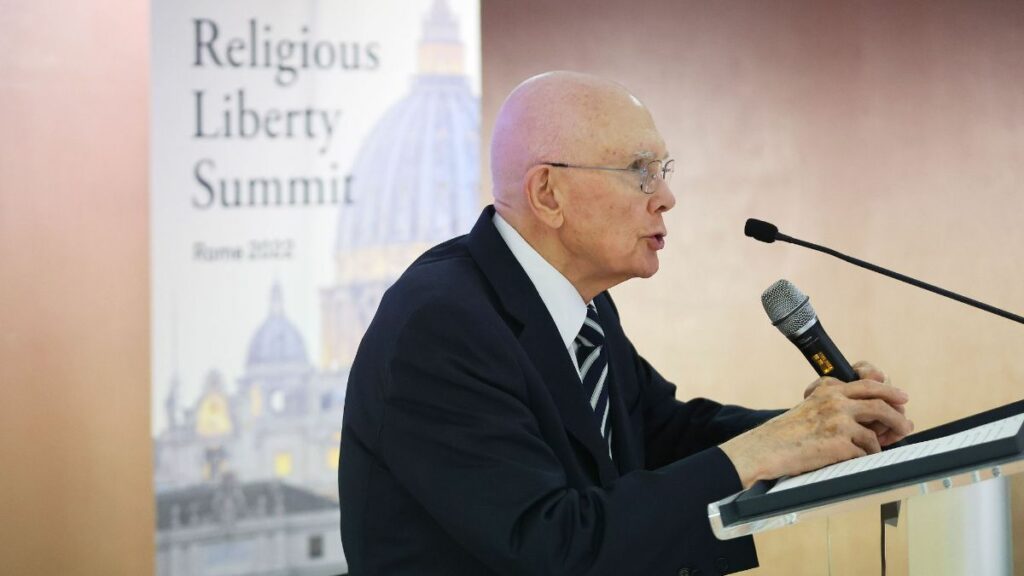“From Rome, this great cradle of the Christian faith, I call for a global effort to defend and advance the religious freedom of all the children of God in every nation of the world,” declared President Dallin H. Oaks on July 20, 2022. That such a statement would come from President Oaks—distinguished religious leader and former president of Brigham Young University, law professor, and justice of the Utah Supreme Court—is hardly surprising. What is surprising is the context in which he spoke: as part of a keynote address to the Notre Dame Religious Liberty Summit at the Pontifical Gregorian University near the Vatican.
“Why,” he asked, “would a leader of The Church of Jesus Christ of Latter-day Saints be invited to speak about religious liberty at a Notre Dame symposium in Rome?” Noting that persecution has been endured by Latter-day Saints as well as Catholics, he then quoted from a speech given at BYU over a decade ago by Cardinal Francis E. George.
Catholics and Mormons [must] stand with one another and with other defenders of conscience… in the defense of religious liberty. In the coming years, interreligious coalitions formed to defend the rights of conscience for individuals and for religious institutions should become a vital bulwark against the tide of forces at work in our government and society to reduce religion to a purely private reality.
To appreciate the great gift of religious liberty we are called upon to defend, it helps to reflect on the three major inflection points in its modern development as identified by President Oaks. First was the United States Constitution, including its First Amendment promising free exercise of religion and freedom of speech and assembly.
Second was the 1948 Universal Declaration of Human Rights acknowledging the universal right to “freedom of thought, conscience and religion,” and that “All human beings are born free and equal in dignity and rights. They are endowed with reason and conscience and should act towards one another in a spirit of brotherhood.”
Third was the 1965 Vatican II Declaration on Religious Freedom, or Dignitatis Humanae, which essentially “declared the root principle that each person, made in the image and likeness of God, has inherent dignity and is therefore created to be free and to enjoy religious freedom.”
President Oaks then quoted his friend Professor Mary Ann Glendon as saying that “Catholic leaders take their bearings on religious freedom mainly from the teachings of Vatican II as expounded [subsequently] by Saint Pope John Paul II,” who stated, “Religious freedom, an essential requirement of the dignity of every person, is a cornerstone of the structure of human rights, and for this reason, an irreplaceable factor in the good of individuals and of the whole of society as well as of the personal fulfillment of each individual.”
President Oaks added that “Pope John Paul II committed his heartfelt efforts to the defense of religious freedom, speaking as a religious leader to a worldwide audience. All who are committed to the free exercise of religion are indebted both for Dignitatis Humanae and for John Paul II’s vision and advocacy.”
Dignitatis Humanae was also the theme of the Religious Liberty Summit itself, which awarded Professor Glendon—Learned Hand Professor of Law, emerita, at Harvard Law School, former U.S. Ambassador to the Holy See, and past President of the Pontifical Academy of Social Sciences—the Notre Dame Prize for Religious Liberty. That the Summit was happening in Rome was noteworthy, declared Marcus Cole, Dean of Notre Dame Law School, in his introduction.
This city—Rome—should remind all of us that no empire or entity is impervious to the truth. We sit here in the capital of the most powerful empire the world has ever known. The ruins of that empire are all around us. As my Lord and Savior, Jesus Christ told us in Matthew 24:2, “Do you see all of these buildings? Truly I tell you that they will be completely demolished. Not one stone will be left on top of another.” Look around you. Your own eyes are witness to the truth of His words. The once great Roman empire was brought down—conquered—by an idea. That idea was a faith. The Romans laughed at a faith, but in the end, their laughter ended. So, the enemies of religious freedom can laugh at us now, but we will not go away. We will continue to fight for freedom of conscience and freedom of religion until it is enjoyed by all.
How do we fight for religious freedom? President Oaks, whose address received a standing ovation and who, incidentally, is an honorary board member of the International Organization for the Family, offered four suggestions.
- “Accept the twin realities that we are all fellow citizens who need each other and that we are all subject to law.”
- “Oppose the use of state- or religion-supported coercion on the sacred subjects of religious choice and activity.”
- “Teach and act to make the beneficial public effects of religious teachings and practices more visible to nonbelievers.”
- “Unite and find common ground for defending and promoting religious liberty.”
Summarizing, President Oaks urged all to move forward together.
With the love and mutual respect taught by divine commandments, we need to find ways to learn from one another and to reinforce the common commitments that hold us together and promote stable pluralistic societies. We should walk shoulder to shoulder along the path of religious freedom for all, while still exercising that freedom to pursue our distinctive beliefs.
Such unity was already evident in the similarity of what Dean Marcus Cole stated: “None of us has all of the answers, or all of the resources. It is our hope that we can learn from, and borrow from, each other…. Together we can be a force for good in the world.”
